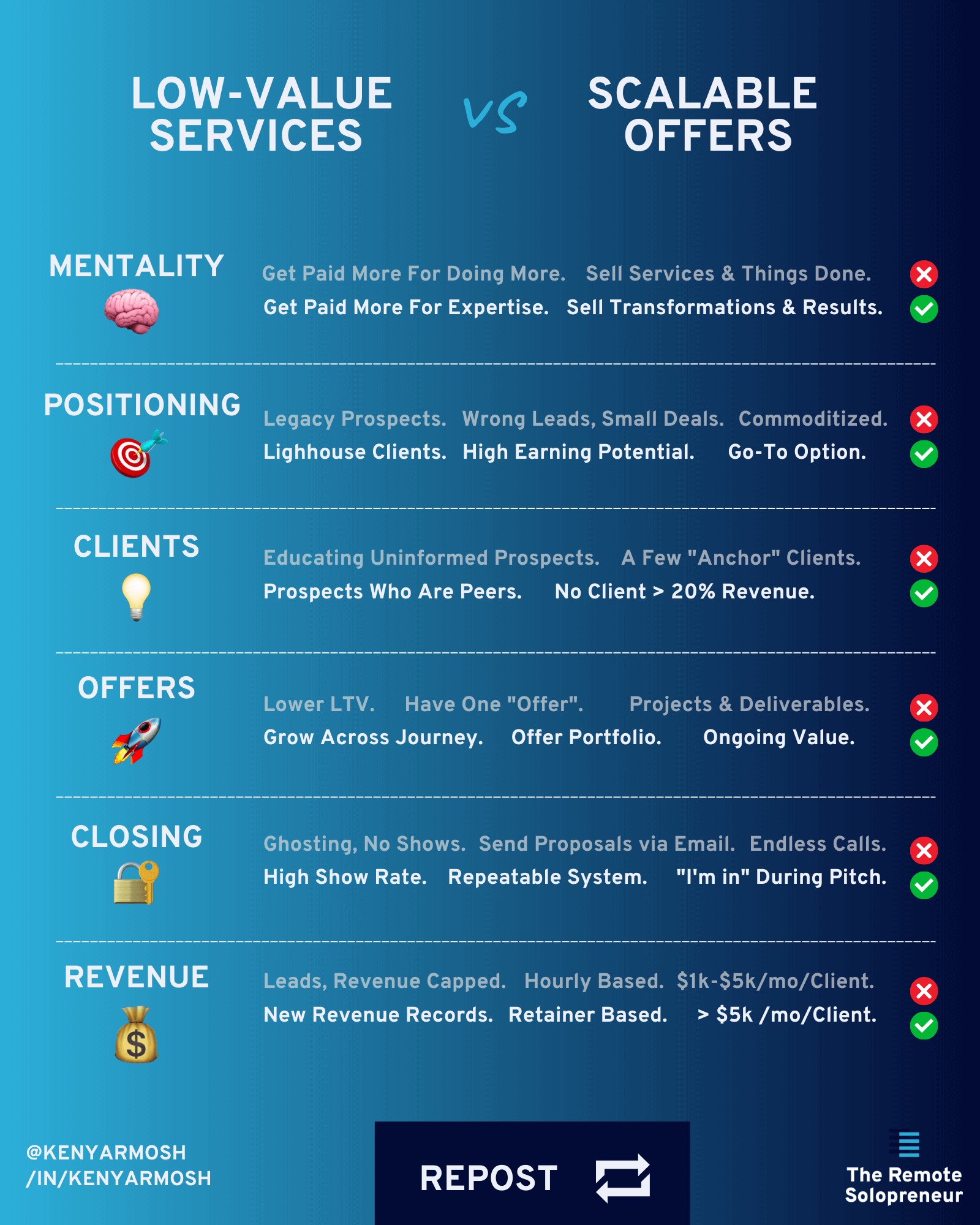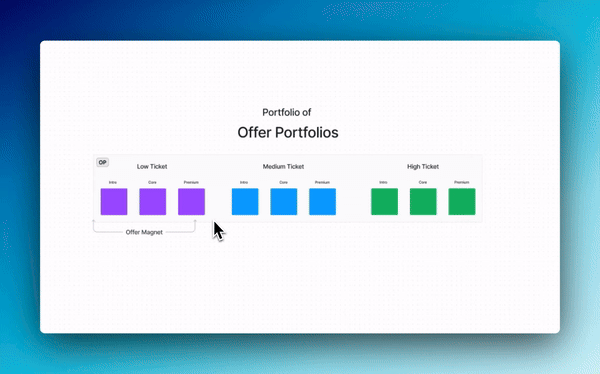🚀 TL;DR
- Trying to scale by trading more time for deliverables/projects leads to burnout. Real scale comes from packaging and positioning your expertise around outcomes rather than tasks.
- A Scalable Service Offer solves a high-value problem, delivers tangible outcomes, is repeatable, and is priced for value instead of hours.
- Traditional frameworks often fail solopreneurs because they focus on deliverables, team scaling, or efficiency instead of premium clients and transformations.
- The framework has 5 parts: identify Lighthouse Clients, design a Blue Ocean Service, optimize channels, build an Offer Portfolio, and run a Repeatable Closing System.
- When integrated, these elements create a flywheel: better positioning → better clients → stronger sales → more impact and income with less grind.
Trading time and money for deliverables, milestones, and projects is a recipe for burnout. I built my first seven-figure business in 2008 without a big team, and I've helped over 500 consultants do the same since then.
The difference between those who scale and those who stay stuck isn't talent.
It's how they package and position their expertise.
Look around, and you'll see the same advice everywhere: "Productize your services to scale."
This advice sends consultants down a dangerous path.
They try to force their custom work into rigid packages. They strip away the personal touch that made them valuable in the first place. They focus on templating deliverables instead of amplifying outcomes.
And clients notice. When your service becomes a commodity, you lose what made you special.
In this article, I’ll explain the Scalable Service Offers framework for one-person businesses and why it matters.
What's a Scalable Service Offer?
A scalable service offer is fundamentally different from a typical consulting package. It's built around transformation and results, not just time or tasks.
Traditional service models cap your income because they're based on deliverables and hours. Scalable service offers are built on outcomes and value, allowing you to command premium rates while working with fewer clients.
Think about this: When McDonald's wanted to scale, they didn't hire more chefs or create fancier meals. They designed simple, repeatable offers that consistently solved a problem.
When Apple scaled, they didn't create more complex products. They simplified and focused on clear, compelling offers that customers immediately understood.
The same principle applies to your consulting business.
Scalable service offers have these critical elements:
- They solve a specific, high-value problem for a defined audience
- They have clear, tangible outcomes that clients can visualize
- They follow a repeatable process that you can systematize
- They position you as the unique solution, not a commodity option
- They're priced based on the transformation, not your time
Why traditional frameworks fail one-person businesses
You've probably tried traditional business frameworks. Maybe the Value Proposition Canvas or the Business Model Canvas. These tools work well for startups and larger businesses, but often fail expert service providers.
Why do they fall short?
First, they're too focused on deliverables, not transformations. They optimize tasks and operations instead of results and value. They help you deliver more efficiently but don't fundamentally change how clients perceive your value.
Second, they assume you're building an agency with employees. Most frameworks are designed for teams, not solopreneurs who need leverage without hiring.
Third, traditional frameworks ignore premium client dynamics. They don't help you identify or attract what I call "Lighthouse Clients"—the ideal, premium clients who value your expertise and willingly pay for outcomes.
And finally, they fail to scale the sales process. You still end up writing custom proposals, engaging in endless discovery calls, and hoping prospects don't ghost you.
We need a framework designed specifically for expert service providers who want to scale without adding overhead.
The Scalable Service Offers framework
After helping hundreds of consultants escape the time-for-money trap, I've developed a framework that consistently works. It's built around five key elements transforming how you package, position, and sell your expertise.
Let's break it down.

1. Identify your Lighthouse Clients
The foundation of any scalable offer is knowing exactly who it's for.
Most consultants try to appeal to everyone. They create generic offers that fail to excite anyone. But premium positioning starts with deliberate exclusion—being crystal clear about who your offer is perfect for, and by extension, who it's not for.
Lighthouse Clients aren't just any clients. They're the ones who:
- Have the exact problem your expertise solves
- Value outcomes over deliverables
- Have the budget for premium services
- Respect your expertise and process
- Would recommend you without hesitation
Your goal is to replicate your best clients of all time, not chase every potential opportunity.
Start by mapping your client relationships. Look beyond basic customer demographics to understand the full profile of your ideal client—their pain points, decision-making process, and what they truly value.
For example:
- Who are the economic buyers in these organizations?
- What specific language do they use to describe their challenges?
- How do they measure success?
This deep understanding lets you craft messaging that resonates specifically with these premium prospects.
2. Design your Blue Ocean Service
Commoditization is the enemy of premium pricing. When prospects see you as interchangeable with other options, you're forced to compete on price rather than value.
The solution? Create a Blue Ocean offer—something prospects can't easily compare to alternatives.
Traditional consultants operate in a Red Ocean, competing directly with similar services. They get stuck in pricing battles and endless proposal revisions.
Blue Ocean strategy in consulting means crafting a unique value proposition that combines elements no one else offers in quite the same way. It's about how you frame the pain relievers and gain creators to highlight your distinctive approach.
Your Blue Ocean offer should incorporate:
- A signature methodology or framework
- A distinctive delivery approach
- Unique combinations of services that solve problems holistically
- Specialized expertise for a specific industry or situation
- A contrarian perspective that challenges conventional wisdom
The Scalable Service Offer is just one example of such an offer 😉
When clients can't easily compare you to alternatives, price sensitivity diminishes, and your expertise becomes the deciding factor rather than your rates.
3. Optimize your channels
Even the perfect offer fails if the right prospects never see it.
Many consultants make the mistake of marketing everywhere, spreading themselves too thin across multiple channels. They post on LinkedIn, write blog articles, create videos, and speak at events, but still struggle to generate consistent leads.
Strategic distribution means being present where your Lighthouse Clients already are, with messaging that speaks directly to their specific challenges.
This requires a deep understanding of your Go-to-Market Strategy (GTM). Where do your ideal clients already gather? What channels do they trust? Who influences their decisions?
Effective channel optimization includes:
- Identifying 1-3 primary distribution channels where your Lighthouse Clients already exist
- Crafting channel-specific messaging that addresses their particular pain points
- Building relationships with trusted influencers and referral partners
- Creating valuable resources designed specifically for these channels
- Measuring and optimizing each channel based on actual client acquisition
Remember: being the go-to expert in one channel is infinitely more valuable than being forgettable across many.
4. Build an Offer Portfolio
The most successful consultants don't rely on a single offer. They create an intentional portfolio that maximizes client value over time.
This doesn't mean having dozens of random services. It means having strategically designed offers that work together, creating multiple entry points and opportunities for expansion.
Your offer portfolio should include:
- Intro offer: A low-risk way for prospects to experience your expertise (assessment, audit, roadmap)
- Core offer: Your primary service that delivers the central transformation clients seek
- Premium offer: Retainer or maintenance offers that provide continued value after the initial engagement
- Expansion Opportunities: Adjacent services or advanced options for clients who want more—which could help you build a Portfolio of Offer Portfolios

This portfolio approach solves several scaling challenges. It creates clear client journeys, increases lifetime value, and allows you to serve clients at different stages of readiness.
It also aligns perfectly with the Business Model Canvas approach, letting you systematize your pricing, packaging, and delivery for each offer type.
5. Run a Repeatable Closing System
The final piece of the framework addresses how you convert prospects into clients.
Traditional sales approaches rely heavily on custom proposals, multiple discovery calls, and hope-based follow-up. This creates unpredictable results and consumes enormous amounts of time.
A repeatable closing system uses proven sales frameworks to move leads to clients with minimal friction. It's built on understanding the psychology of how economic buyers make decisions.
The key elements include:
- A structured qualification process that identifies ideal prospects early
- Conversation frameworks that uncover true pain points and buying motivations
- Value-based pricing discussions that focus on outcomes, not hours or deliverables
- Proposal templates that emphasize transformation rather than tasks
- Clear next steps and decision timeframes to prevent ghosting
You’ll also eliminate the emotional roller coaster of custom proposals and uncertain outcomes.
Scalable Service Offers is the only offer framework you need
The magic happens when these five elements work together as an integrated system.
Your Lighthouse Client targeting informs your Blue Ocean positioning, which shapes your channel strategy, supports your offer portfolio, and enables your closing system.
This is why piecemeal approaches to scaling rarely work. You need all five elements working in harmony.
When implemented correctly, this framework creates a flywheel effect:
- More targeted marketing attracts better-qualified prospects
- Better-qualified prospects respond to your unique positioning
- Your offer portfolio provides clear next steps for every client
- Your closing system converts more prospects with less effort
- Successful clients become advocates, attracting more Lighthouse Clients
This isn't theory. I've seen this framework transform businesses across industries—from financial advisors to software developers, from marketing consultants to leadership coaches.
The common thread? They stopped trying to scale through more clients, deliverables, or employees. Instead, they focused on creating scalable service offers that leveraged their expertise.
As a result, your income grows, your impact expands, and you reclaim the freedom that probably inspired you to start your business in the first place.

